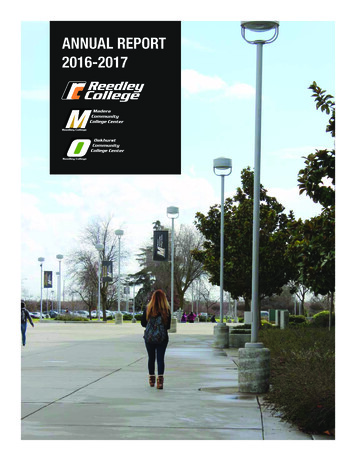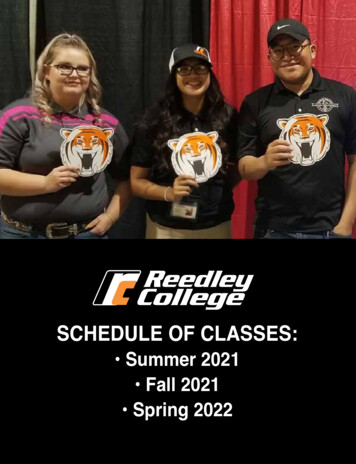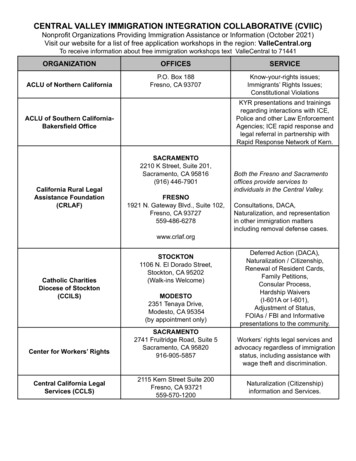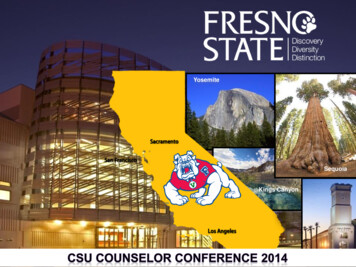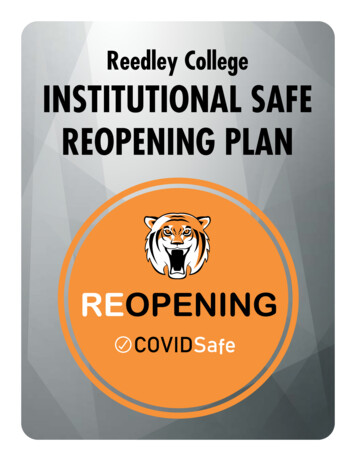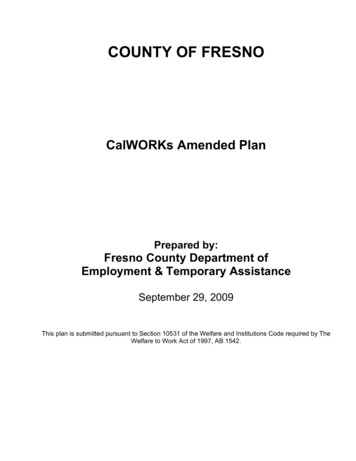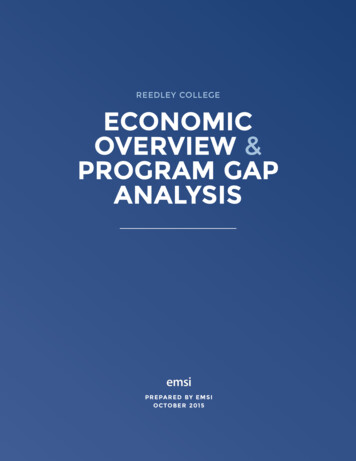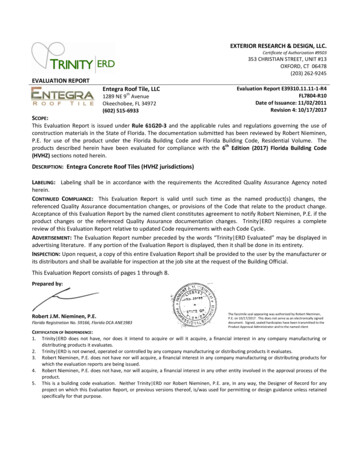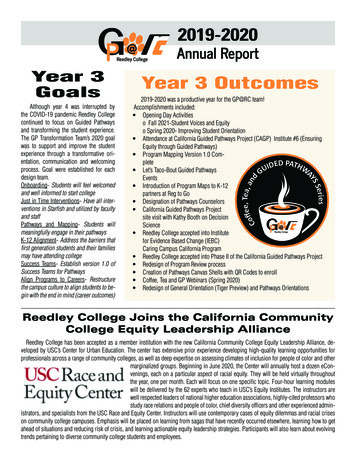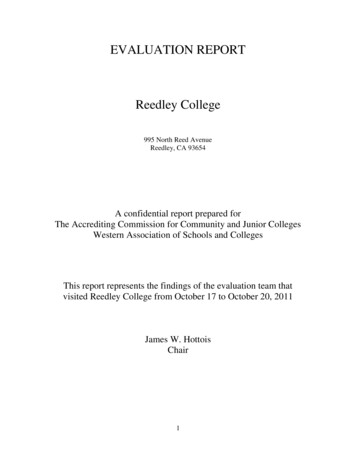
Transcription
EVALUATION REPORTReedley College995 North Reed AvenueReedley, CA 93654A confidential report prepared forThe Accrediting Commission for Community and Junior CollegesWestern Association of Schools and CollegesThis report represents the findings of the evaluation team thatvisited Reedley College from October 17 to October 20, 2011James W. HottoisChair1
Visiting Team RosterDr. James W. HottoisSuperintendent/PresidentPalo Verde CollegeTeam ChairDr. Elizabeth ArmstrongFormer Interim PresidentSan Diego Mesa CollegeTeam MemberMs. Kathy BlackwoodInterim Executive Vice ChancellorSan Mateo County Community College DistrictTeam MemberDr. Edmund BuckleyFormer Vice President, Academic Affairs/Assistant SuperintendentSanta Rosa Junior CollegeTeam MemberMs. Merrill DemingInterim Dean, School of Mathematics and ScienceChaffey CollegeTeam MemberMs. Lurelean GainesChairperson, Department of NursingEast Los Angeles CollegeTeam MemberDr. Sherrie GuerreroVice President of Instruction and Student ServicesChaffey CollegeTeam MemberDr. Carol KozerackiDean, Research and PlanningLos Angeles Pierce CollegeTeam MemberDr. Donna McGill-CameronProfessorWoodland Community CollegeTeam MemberMs. Kerrin McMahanDean, Academic AffairsEast Los Angeles CollegeTeam MemberMs. Carrie MullionAdministrative Assistant to the Superintendent/PresidentPalo Verde CollegeTeam Assistant2
SUMMARY OF EVALUATION REPORTINSTITUTION: Reedley College, State Center Community College DistrictDATES OF VISIT: October 17 – October 20, 2011TEAM CHAIR: James W. HottoisAn eleven-member accreditation team visited Reedley College from October 17 toOctober 20, 2011, for the purpose of evaluating how well the institution is achieving itsstated purposes, analyzing how well the college is meeting the Commission Standards,providing recommendations for quality assurance and institutional improvement, andsubmitting recommendations to the Accrediting Commission for Community and JuniorColleges (ACCJC) regarding the status of the college.In preparation for the visit, team members attended an all-day training session onSeptember 1, 2011, conducted by the ACCJC and studied Commission materialsprepared for visiting teams. Team members read carefully the college's self study report,including the recommendations from the October 25 through 27, 2005 visiting team, andassessed the evidence provided by the college.Prior to the visit team members completed written evaluations of the self study report andbegan identifying areas for further investigation. On the day before the formal beginningof the visit, the team members spent the afternoon discussing their views of the writtenmaterials provided by the college, reviewing evidence provided by the college andreviewed the Progress Report completed by the college in October of 2006 along withother materials submitted to the commission since its last comprehensive visit. Thoseother materials included the report and recommendations of a Team which visitedReedley College on behalf of the Commission in October 2006. The team also reviewedthe College’s 2008 Interim Report to the Commission.During the visit, the team met with over 100 faculty, staff, administrators, members of theBoard of Trustees, and students. The team chair and other members of the team met withmembers of the Board of Trustees, the president of the college and various administratorsat Reedley and at each of the North Centers. In addition, team members visited thesatellite campuses at Willow-International, Madera and Oakhurst. The team alsoattended two open meetings to allow for comment from any member of the campus orlocal community.The team’s visit was made more complex by the fact that a second team was visiting theWillow International Center with the purpose of determining candidacy status for thatcenter. According to the Willow International self study it appears that the proposed newcollege will include the Madera and Oakhurst Centers both of which, along with theWillow International Center, were under the administrative supervision of the ViceChancellor for North Centers rather than the President of Reedley College at the time of3
our visit. However, discussions with various administrators at the District and at ReedleyCollege indicated that at the time of this visit there was no clear decision about the futureorganizational status of Madera and Oakhurst and that the Commission’s rules preclude acandidate college from having off-campus centers or sites.The team felt that the self study report was comprehensive and thorough. College staffmembers were very accommodating to team members and available for interviews andfollow-up conversations. The college was well prepared and ready for the team's visit.4
MAJOR FINDINGS AND RECOMMENDATIONSOF THEOCTOBER 17 – 20, 2011 VISITING TEAMCommendations:1. The college is commended for its ability to acquire approximately nine milliondollars of grant funding which has helped the college provide excellent programming in anumber of academic areas. These grant awards are a testament to the hard work ofcollege employees in the service of students.2. The college is to be commended for having, with Fresno City College, one of theonly psychological services programs for students in California community colleges thatis accredited by the American Psychological Association. This program providesinvaluable counseling and intervention services for students.3. The college is commended for the extensive array of agriculture and naturalresources programs existing at the college, along with significant partnerships withbusiness that provide invaluable training and internship opportunities for students.4. The college is to be commended for the enthusiasm, attention, and collegiality it hasbrought to assuring broad communication on all matters to the members of the collegecommunity and for developing formal and informal structures and processes, such as theParticipatory Governance Handbook, to facilitate participation.5. The college is commended for their robust Disabled Student Programs and Services(DSPS), which excel in providing outreach to all groups of students to ensure theyreceive needed assistance.Recommendations:College Recommendation 1As recommended by the 2005 Accreditation Team and to build on its achievements todate in developing program review and improving institutional planning, the collegeshould develop a practical, integrated planning model with the following characteristics:1. A focus on a limited number of mid- to long-term initiatives to improve studentlearning and student support services.2. A plan with concrete strategies and actions that are specific, measurable, attainable,results-oriented and time based, and that specify individuals or groups responsible fortheir completion.3. A process that clearly ties this planning model to the college's resource allocationprocesses.5
4. Processes for regularly assessing not only the progress in achieving the goals of theplan but also the effectiveness of the integrated planning model itself.5. A model that is inclusive of all institutional planning activities and that clarifies thefunctions of program review and the various resource committees.6. A planning model that clarifies the relationship of the planning processes at ReedleyCollege and the other planning processes of the State Center Community CollegeDistrict.(Standards I.B.1 through I.B.7; II.A.2, II.B, II.C, III.A, III.A.6, III.B, III.B.2, III.C,IIIC.2, III.D, III.D.1, III.D.3, IV, IV.A, IV.A.1, IV.A.5, IV.B.1, IV.B.3.g.)College Recommendation 2In order to meet the Standard and the Commission’s 2012 timeline to be at the“proficiency level” in the identification, assessment and use for improvements of studentlearning outcomes, the team recommends that the college accelerate its activities toensure that each course and program has measurable outcomes that are published widely,that those outcomes are regularly assessed, that the results of that assessment are clearlydocumented, widely discussed, and used in decision making aimed at aligning institutionwide practices to support and improve student learning (II.A.1.a, II.A.1.b, II.A.1.c, II.A.2,II.A.3).College Recommendation 3In order to meet Standards, the team recommends that the college further clarify itsparticipatory governance decision-making structures and processes to identify clearly theresponsibilities of committees and individuals for decision-making.(Standard: IV.A.2.a; IV.A.3; IV.A.5)District Recommendation 1In order for the colleges and District to fully meet the intent of the previousrecommendation, the State Center Community College District must engage incontinuous, deliberative, and timely dialog with all District stakeholders to coordinatelong term planning and examine the impact on all the stakeholders of the plannedincrease in the number of colleges and the future roles of the centers. This includescreating, developing, and aligning District and college plans and planning processes inthe following areas: strategic planning, facilities planning, technology planning,organizational reporting relationships of centers, locations of signature programs, fundingallocation, and human resources and research capacity. (Standards: I.B.1, I.B.2, I.B.3,I.B.4, I.B.6, I.b.7, III.A.2, III.A.6, III.B.1.a, III.B.2.b, III.C.2, III.D.1, IV.A.5, IV.B.3.a,IV.B.3.c)District Recommendation 2In order to improve institutional effectiveness, the team recommends that the Districtdocument the process for review of board policies and ensure that district governance and6
decision-making processes are regularly evaluated (Standards: IV.B.1.e, IV.B.3.g.)7
ACCREDITATION EVALUATION REPORTFORREEDLEY COMMUNITY COLLEGEIntroductionReedley College is one of two colleges within the State Center Community CollegeDistrict.Reedley Junior College was established in 1926 as part of the Reedley Joint Union HighSchool District. On July 1, 1946, Reedley Junior College was renamed Reedley College.In September 1956, Reedley College moved to its present 72-acre site, which is locatedon Reed and Manning Avenues. The College’s site now includes 300 acres used as farmland.One of two community colleges that currently make up the State Center CommunityCollege District, Reedley College serves several municipalities and communities locatedoutside of the City of Fresno, California. The college hosts three major educationalcenters located in the communities of Madera, Clovis, and Oakhurst, referred tocollectively as the North Centers. At the time of this visit, the North Centers were notunder the administrative authority of the President of Reedley College. The college alsoprovides educational opportunities to citizens located in rural communities south ofReedley. These locations are referred to as South Centers/Community Campus Program.The Reedley College campus is located in the City of Reedley, California, which is anethnically diverse area with a population of approximately 26,000 people. Studentenrollment for Reedley College (including the North Centers) for the 2010 fall semesterwas 14,768. FTES enrollments for Fall 2010 was 5,259. Reedley College accounted for50% of the FTES enrollment with the North Centers accounting for the other 50%.Hispanics make up 64 percent of the student enrollment with Caucasians the next largestgroup at 22 percent. The ethnic make-up of the College has not changed appreciablysince the last comprehensive Team Visit.The college has fostered close relationships with its surrounding communities,and those communities exhibit a strong sense of support for the college. Studentenrollment at the North Centers is approximately 9,200 students with about 60 percentenrolled at the Willow International Center, which is located in Clovis, a suburb ofFresno. Approximately 93,000 people live in Clovis, and it is the fastest growingpopulation in the Fresno area with a 36% increase between 2000 and 2009. FTESenrollments during the fall 2010 semester at the North Centers were reported as follows:Oakhurst Center - 143, Madera Center - 820, and Clovis Center – 1,652. Having achieveda steady growth over the past five years, the Clovis Center is now the largest of the North8
Centers, generating almost 1,652 credits FTES in 2010—a 47% increase since 2005. Bycontrast, Reedley College’s campus growth was 16% during the same period.The Willow-International Center is seeking candidate status as a community college. Atpresent the North Centers make up slightly over 50% of Reedley College’s enrollment.In the last several years, enrollment growth and responsible fiscal stewardship, coupledwith funds secured through the passage of a local construction bond measure, haveprovided the college with the resources necessary to expand services, hire additionalfaculty and staff, and improve campus maintenance. While still focusing on its successfulvocational programs, the college has placed a strong emphasis on improving transfer inrecent years.Reedley College and the North Centers are well kept and attractive due to the district’sinvestments in basic maintenance and the dedicated building and grounds staff. Themorale of administrators, faculty, and staff is very positive, as evidenced by the self studyand through interviews by the visiting team.9
Evaluation of Institutional Responses to Previous RecommendationsThe report of the Team which visited Reedley College in October, 2005 included sixrecommendations. All six recommendations were adopted by the Commission at itsJanuary meeting in 2006. Apropos of this report, the Commission added the followingcomment in its January 31, 2006 letter to the College: “The Commission is unclearregarding the District’s Plans for Reedley College’s center in Clovis and Madera whichthe team heard would eventually grow into colleges.”On October 31, 2006, after reviewing the progress report prepared by the College inresponse to the Team and Commission recommendations, a team visited Reedley Collegeand arrived at conclusions based on its observations. Those conclusions are summarizedafter each recommendation.2006 Recommendation 1: Student Learning OutcomesThe team recommends that the college conduct meaningful, timely, and inclusivedialogue with all constituent groups to identify, develop, and implement student learningoutcomes at the course, program, and degree level. The college should determine andimplement relevant assessment methodologies and procedures to evaluate studentlearning outcomes and enhance institutional effectiveness. (Standards I.B.1, I.B.4, I.B.7,II.A.1c, II.A.2a, II.A.2b, II.A.2e, II.A.2f, II.A.2g, II.A.2i, II.A.3, II.A.6, II.A.6a, II.B.1,II.B.4, II.C.1a, II.C.2, III.A.1b, III.A.1c, IV.A.1, IV.A.2b, IV.B.1b)Conclusion of the 2006 Team: By fall of 2006 a progress report visiting team foundthat the college had “ made significant progress in understanding student learningoutcomes” by attending workshops and retaining a consultant. The 2006 teamrecommended “that in order to fully meet the standards the college continue efforts toinstitutionalize the student learning outcomes/assessment/analysis/improvement cycle.”Conclusion of the 2011 Team: In the Self Study the college asserts that its Curriculumand Program Review committees have continued the work on the process of identifyingstudent learning outcomes and assessment methods in the Course Outlines of Record andthat all courses currently have SLOs.The program review process was revised in March 2007 to include the process by whichSLOs are developed, assessed and evaluated at the certificate, degree and programlevels. The faculty met in spring 2009 and fall 2010 (to work on course and programassessment); during 2010-2011 academic year a series of division Student LearningOutcomes summits were held for each department to work on mapping the relationshipsof course-program-general education (institutional) outcomes. In 2008 the facultymember who chairs the Program Review Committee was reassigned to work with facultyand staff on the development, assessment and evaluation of student learning outcomesand is currently taking inventory of the completed program review annual progressreports and SLO assessments; these are posted each semester on the Blackboard StudentLearning Outcomes and Assessment site.10
The college asserts that Program Learning Outcomes (PLOs) have been identified for allprograms although “ the process of assessment and improvement of each is still inprogress for the majority of our programs.” The identified PLOs are said to be listed inthe college catalog. A review of the 2010-2012 catalog does not reveal evidence of theseoutcomes although the online Addendum to the catalog does list PLOs for thoseprograms that have been recently reviewed.Degree level outcomes (General Education Learning Outcomes or GELOs) have beenidentified.A process was developed that would map key courses to the appropriate GELO orprogram outcome on the assumption that successful completion of the key courses wouldconstitute achievement of the learning outcome. This mapping activity appears to beconducted at the department level and is captured for those on the Blackboard SLO sitefor those departments that have completed it. There is evidence that the college hasidentified key courses that incorporate the outcomes of the GELOs and that these havebegun to be evaluated.The team concludes that Reedley College has met this recommendation2006 Recommendation 2: Institutional PlanningThe team recommends that the college develop, implement, and evaluate a college widestrategic plan that incorporates the individual planning efforts of the college and centers.The college wide strategic plan should include assessment of student and communityneeds in order to determine the efficiency of college programs and services and toimprove institutional effectiveness. Additionally, the strategic plan should identify anddefine the allocation of fiscal, physical, human, and technical resources that are requiredduring all operational hours for existing centers and campuses and those that will beneeded as future centers and campuses are developed. (Standards I.B.1, I.B.2, I.B.3,I.B.4, I.B.6, I.B.7, III.A.2, III.B.1, III.B.1a, III.B.1b, III.B.2, III.B.2a, III.B.2b, III.C.1,III.C.1.a, III.C.1c, III.C.1d, III.C.2, III.D, III.D.1a, III.D.1b, III.D.2b)Conclusion of the 2006 Team: “While the team recognizes that all constituent groupshave made significant strides in developing and implementing a comprehensive strategicplan, efforts should continue at the same level of commitment if the college is to achievethe recommendation listed in the Commission’s report of October 2005.”Conclusion of the 2011 Team: The college notes that since the last visit, ReedleyCollege has developed a Strategic Planning Committee (SPC) with representatives fromall constituencies including the North Centers College Council. The SPC has a clearlydefined purpose and has conducted a series of focus groups that have resulted in anapproved Reedley College five-year Strategic Plan and a Strategic Planning and ActionPlanning Master Calendar. In 2009-2010, the Reedley College Resource Action Planproposal form was developed that links the college strategic plan and goals with the11
outcomes of program review. An Educational Master Plan was developed in 2009-10. Infall 2010, the SPC evaluated the Strategic Plan and determined that a consistent use ofdata by programs was necessary; therefore a template was generated to address this need.The response indicates that further revisions were to be considered in spring 2011. Thecollege is currently reviewing a draft version of an overall integrated strategic planningprocess.The college is addressing this recommendation and has begun to put into place anintegrated planning process. The college has been assessing its integrated plannngprocess and changes have been made to improve the effectiveness of that process. Thusprogress has been made. However, aspects of the planning process still need to beaddressed, particularly the development of concrete, well-focused, results-orientedstrategies and action plans, and protocols to assure that institutional planning is firmlyconnected to strategic resource allocaton.The team concludes that the college has not fully addressed this recommendation.2006 Recommendation 3: DialogueThe team recommends that the college improve communication by engaging in dialoguethat is inclusive of all constituents, informed, and intentional about institutional qualityand improvement. The dialogue should purposefully contribute to planning andinstitutional change. This dialogue must include formal and informal pathways foreffective communication links and conflict resolution mechanisms so that informationand recommendations are equally accessible to all constituent groups and centers.(Standards I.A.3, I.4, I.B.1, I.B.2, I.B.3, I.B.4, IB.5, IB.6, IB.7, IVA.1)Conclusion of the 2006 Team: “While this recommendation has been partially met, theteam recommends that constituent groups at Reedley College and the North Centerscontinue this important effort to improve communication to fully meet the Commission’srecommendation.”Conclusion of the 2011 Team: The team found that a variety of methods have beeninstituted to address this recommendation. These include workshops and all-collegeretreats; regular meetings of constituent groups and leadership; governance representationon committees including students; use of technology for communication and collegebusiness; Tiger Talk gatherings between employees and administrators; wide distributionof agendas and minutes; charrettes for review of strategic planning; and newsletters. Indiscussions with members of the college community, the team confirmed that there is ahigh level of satisfaction with the efforts made to enhance communication and afford allthe opportunity for input.The Team found that this recommendation has been met. Reedley College has a culturein which input from all constituents is valued.12
2006 Recommendation 4: Program ReviewThe team recommends that the college implement the revised program review process.This process should include the assessment of student learning outcomes along with otherassessments that yield quantitative and qualitative data for analysis. This informationshould be used for planning, decision-making, program improvement, and resourceallocation. (Standards I.B, II.A.2, II.A.1c, II.B.1, II.B.3, II.B.4, II.C.2, III.A.1c, III.A.6,III.C.2, IV.A.1, IV.A.2)Conclusion of the 2006 Team: “The revised program review policy appears to be agood effort to conduct a reliable self-assessment of all programs and tie the results toplanning and budget allocations. However, while this recommendation has been met,the team recommends that the college continue to apply and evaluate the revised programreview process to ensure that expectations of the Commission continue to be satisfied.”Conclusion of the 2011 Team: In the Self Study the college describes the ProgramReview, Cycle 2 process as including the identification of student learning outcomes andthe assessment method by which student achievement of those outcomes will bemeasured as well as data analysis of student demographics, course and enrollmentinformation, and student achievement indicators. All programs at the college undertakesuch a review every six years with annual reports due in non-review years. The results ofthe program review are presented to the College Council which also deals with planningand resource allocation.In addition the program review may be referenced when applying for non-general fundresource support through the college’s Resource Action Plan initiated fall semester 2007.The parallel process for the North Centers is the Action Plan Funding Request. Since2007 the College Council (the College Center Council at the North Centers), which isresponsible for planning and resource allocation, reviews and accepts program reviewsummary sheets.The team concludes that the college has met this recommendation.2006 Recommendation 5: Library and Learning ResourcesThe team recommends that the college fully implement the previous team’srecommendation by ensuring that professionally qualified library and learning resourcestaff provide support at all locations where these services are offered currently and willbe needed as future centers and campuses are developed. (Standards II.C.1a, II.C.1b,II.C.1c, II.C.2)Conclusion of the 2006 Team: “ the Commission should continue to monitor thecollege’s effort to fill this position as recommended by two evaluation teams (2000 and2005).”Conclusion of the 2011 Team: Since the 2005 report, a professional librarian has beenhired to serve the North Centers. This librarian is assisted by two part-time classified staff13
working 19 hours per week each to provide evening service at the Madera and ClovisCenter libraries. On the main campus, there are 2.5 FTE librarians and 4.5 FTE supportstaff. A half-time bibliographic instruction librarian is being paid by grant funds. Ingeneral, library and other learning support services are available to all students, but on anunequal basis, depending on the student’s location and the mode of course delivery.However, the numbers of professional librarians and support staff may be inadequate asWillow International moves toward separate accreditation. The college adequatelyresponded to this recommendation, but needs to plan immediately for forthcomingchanges in staffing needs.The team concludes that this recommendation has been met.2006 Recommendation 6: College Strategic Planning Connection with DistrictStrategic PlanningThe team recommends that the college develop, implement, and evaluate a college-widestrategic plan that 1) incorporates the individual planning efforts of the college and 2)results in a cohesive planning framework. Simultaneously, the college should remaincognizant of the strategic direction of the State Center Community College District as itmoves toward increasing the number of colleges in the district. (Standards I.B.1, I.B.2,I.B.3, I.B.4, I.B.6, I.B.7, III.A.2, III.B.1, III.B.1a, III.B.1b, III.B.2, III.B.2a, III.B.2b,III.C.1, III.C.1a, III.C.1c, III.C.1d, III.C.2, III.D, III.D.1a, III.D.1b, III.D.2b)Conclusion of the 2006 Team: “ the team recommends that Reedley College and theNorth Centers continue to work with the district in order to fully satisfy theCommissions’ recommendation.”Conclusion of the 2011 Team: Reedley College and the State Center CommunityCollege District need to continue their efforts to coordinate strategic planning betweenthe college and the district.The team concludes that the college has partially met this recommendation.14
Eligibility Requirements1. AUTHORITY:Reedley College operated under the California approvals and authorities associated withthe State Center Community College District. Reedley College was founded in 1926 andapproved as a California Community College in 1963. The Willow International Center(formerly the Clovis Center), the Madera Center and the Oakhurst Center conducteducational programs under the jurisdiction of Reedley College. However, as notedbelow, in many ways those Centers, operating as the North Centers, are administrativelyseparate from Reedley College.2. MISSION:The team confirmed that Reedley College’s Mission Statement is regularly reviewed bythe College’s constituent groups and that a revised Mission Statement for ReedleyCollege was adopted by the Board of Trustees of the State Center Community CollegeDistrict in 2011. Since Willow International is working toward accreditation, WillowInternational has developed its own Mission Statement which is distinct from ReedleyCollege’s Mission Statement.3. GOVERNING BOARD:The State Center Community College District Board of Trustees consists of sevenmembers elected for staggered four-year terms from areas within the district. A nonvoting student member is selected by students on an annual basis. The Team confirmedthat the Board of Trustees make policy for the District and the College and supervises theoperations of both. Board members have no employment, family or personal interest inthe District and file an annual conflict of interest statement to this effect.4. CHIEF EXECUTIVE OFFICER:In accord with this Eligibility Requirement, Reedley College has a president who is thechief executive officer appointed by the governing board whose full-time responsibility isto Reedley College and who possesses the requisite authority to administer board policiesat Reedley College. Through long-standing practice, the North Centers (WillowInternational Center, Madera Center and Oakhurst Campus) are administered by a vicechancellor who has been assigned the responsibility of chief executive officer and whoreports to the chancellor of the district. Given the communications between Reedleycollege and the Commission regarding the candidacy of Willow International for separatecollege status, there is a seeming contradiction between the current administrativestructure and this Eligibility Requirement and with Standard IV.B.2 that the team isunable to resolve without clarification from the Commissioin.15
5. ADMINISTRATIVE CAPACITY:The team determined that Reedley College has sufficient administrative staff, alladequately prepared and experienced to operate the college.6. OPERATIONAL STATUS:The team found that Reedley College is fully operational with students actively pursuingdegree and certificate programs in an appropriate number of fields.7. DEGREES:The team confirmed that a substantial proportion of the institution’s educational offeringsare programs leading to degrees or certificates and a significant proportion of theCollege’s students are enrolled in and complete those programs.8. EDUCATIONAL PROGRAMS:The team confirmed that Reedley College offers a range of programs, includingnumerous programs that are two years in lengt
Reedley Junior College was established in 1926 as part of the Reedley Joint Union High School District. On July 1, 1946, Reedley Junior College was renamed Reedley College. In September 1956, Reedley College moved to its present 72-acre site, which is located on Reed and Manning Avenues. The College's site now includes 300 acres used as farm .
